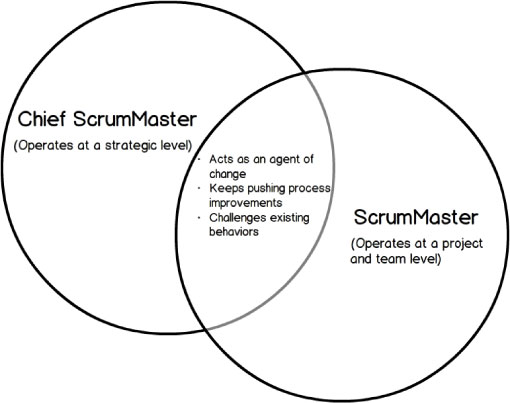When one ScrumMaster turns into two, then three, then four, life begins to gets more exciting. Scrum has clearly taken a stronghold in your organization and is settling in for the long haul.
Although this is a great situation, care must be taken to erect strong scaffolding to help guide the positive surge as well as to maintain a level of consistency and discipline across the expanding groups.
To ensure that problems don’t arise, consider the creation of a new position complete with a fresh remit to maintain standards and consistency. The Scrum equivalent of a PMO (project management office) would be ideal. However, setting up a PMO is no easy feat, and because this blog is about identifying effective shortcuts, I recommend a simpler alternative (at least to start with): the creation of the Chief ScrumMaster position.
ScrumMaster versus Chief ScrumMaster
Although Scrum doesn’t prescribe any functional lead roles, the reality is that there needs to be a person who handles the responsibilities, such as HR, career progression, and technical mentoring, for the various functions. Simply put, the Chief ScrumMaster performs this role for a group of ScrumMasters and also acts as the organization-wide strategic Scrum coach (see Figure 1). If you prefer a looser structure, then you could instead view the Chief ScrumMaster as the facilitator of the ScrumMaster Community of Practice.

Figure 1 – While the roles are different, they share important commonalities
Now that the general relationship between the two roles has been established, let’s explore the specific functions of each, starting with the new Chief ScrumMaster role.
Core Functions of the Chief ScrumMaster
Mike Cohn’s Succeeding with Agile provides an excellent basis for the core functions of a Scrum-based PMO, and I’m going to start with a selection of these functions for our Chief ScrumMaster position description. I have put my own spin on these descriptions, so for Cohn’s original descriptions, please refer to his book.
Training and Coaching
Novice ScrumMasters need to learn how to become good ScrumMasters, and maturing ScrumMasters need to learn how to become great ScrumMasters. Programs need to be created to facilitate this education process.
Challenge Existing Behaviours
Mike Cohn also talks about challenging the teams “who are falling back into old habits.” This is obviously important, but in the case of the Chief ScrumMaster, it is also critical to continually challenge the organization (on a whole) if it slips back into its more systemic bad habits.
Provide and Maintain Tools
Whether the business decides to use high-tech or low-tech tools (or a combination of both), the various artifact templates need to be defined, adapted, and version controlled.
Define and Refine Metrics
Metrics should be used carefully for good rather than evil purposes (see Scrum Metrics and Reporting – Measure What You Manage. The Chief ScrumMaster needs to ensure that relevant metrics have been formulated and are being utilized for the correct purpose.
Help Establish Communities of Practice
Function-specific communities of practice should ideally form organically from the grassroots. However, they will often need the initial kick-start and occasional shot-in-the-arm to keep them running effectively.
Ensure Consistency
Ensuring consistency across teams is possibly the most important function of the Chief ScrumMaster. It is important that consistency and discipline are maintained, especially when there are multiple teams and ScrumMasters. If certain teams need or would like to apply varying approaches (for whatever reason), then these variations should be adopted in a systematic and purposeful fashion with guidance from the Chief ScrumMaster.
Coordinate Teams
With multiple interdependent teams working on the same product backlog, processes need to be defined and maintained to ensure coordination occurs as seamlessly as possible.
In Addition…
The following are some additional functions that I feel can be added to Cohn’s list.
Ongoing Scrum Promotion
Promoting Scrum should occur not only in the early stages of the adoption but also as the organization evolves. New stakeholders will be regularly coming on board, and they will need to understand the incumbent Scrum environment.
Developing the Approach
Remember that Scrum is a framework and not a prescribed method. Therefore, the specific, fit-for-purpose approach for an organization should be initially defined by the Chief ScrumMaster.
Company-Level Education
As each new Scrum initiative or practice gets introduced for the first time, the business needs ongoing education to ensure that the proposed benefits are understood.
Aligning the Teams’ Definitions of Done
Coordinating the defining and evolution of a consistent definition of done across all teams is important to ensure that expectations are aligned, especially during key integration periods.
Continual Process Improvement via Collective Retrospectives
Many useful suggestions will bubble up from the various team sprint retrospectives, and it is important that any golden ideas that Team X comes up with (that other teams may also find helpful) are leveraged across all groups.
Impediment Escalation
Not all impediments that disrupt an individual team can be resolved by the individual ScrumMaster, especially issues relating to organizational constraints, such as the physical working environment and/or incentive schemes. The Chief ScrumMaster should be the first escalation point for such impediments.
HR for the ScrumMasters
Just like everyone else in the organization, ScrumMasters have HR requirements that need to be managed, such as career planning, remuneration reviews, training, and mentoring.
Creating a Physical Environment Conducive to Scrum
To work successfully, Scrum needs to exist in a collaborative and comfortable team environment with minimal disruptions from the outside world. Ensuring a close working relationship with the facilities department who can assist to modify the workplace where and when required is integral to Scrum’s success.
Core Functions of the ScrumMaster Role
When the ScrumMaster is a lone wolf in a small organization, then the Chief ScrumMaster functions listed earlier will also need to be taken on by the ScrumMaster. However, when there is the luxury of a Chief ScrumMaster, the ScrumMaster should then be free to focus primarily on the following roles and responsibilities.
Process Improvement
Identifying key improvement points with help from quantitative metrics (see Scrum Metrics and Reporting – Measure What You Manage) as well as through the more qualitative sprint retrospectives (see Sprint Retrospective Irrespective is a fundamental responsibility of the ScrumMaster.
Impediment Management
One of the most publicized of all ScrumMaster functions is the controlling of impediments to ensure that project speed bumps don’t turn into brick walls. Check out this article about how you to deal with impediments.
Diplomacy
Especially in the early days, silos will likely exist between the various groups who are required to work together in a new Scrum team. Bringing these groups together around the campfire is one of the more subtle, yet critical, responsibilities of the ScrumMaster.
Coaching
It is imperative that the ScrumMaster comprehensively understands the broader Scrum framework, and more specifically, he or she needs to be highly proficient with the approaches adopted among the teams. This includes being an expert with the various tools and techniques being used.
Managing Change
Regular changes will be made to overall product scope as well as individual product backlog items. Controlling these changes and guiding the various parties in managing the changes is extremely important.
Maintaining the Definition of Done
Once the definition of done has been defined by the Scrum team, the ScrumMaster needs to work hand in glove with the product owner and developers to ensure that it is maintained.
Maintaining Effective Communication
Scrum relies on positive human interaction; therefore, the ScrumMaster needs to
actively encourage a culture that allows such interaction to occur.
Updating Artifacts
The ScrumMaster needs to work with the developers to ensure that sprint artifacts are regularly updated (which often requires perfecting the art of chasing without nagging).
Facilitating Workshops
Prior to a project kicking off, the ScrumMaster needs to work with the product owner to facilitate the creation of the product backlog by conducting user story workshops and estimation sessions (see Planning Poker at Pace).
Facilitating Scrum Activities
Several activities occur throughout the sprint iteration, and the ScrumMaster is responsible for their running smoothly. This includes managing the logistics and facilitation of the following:
- Daily scrums (see Outstanding Stand-ups)
- Sprint planning (see Sprint Planning – Plan the Sprint then Sprint the Plan)
- Sprint reviews (see To-dos for Your Sprint Reviews)
- Sprint retrospectives (see Sprint Retrospective Irrespective)
A motivated ScrumMaster will also make efforts to constantly spice up these sessions by introducing various formats and locations to keep life interesting.
A Consistent Ecosystem
Phew! When you read these lists of functions, you can begin to really appreciate that maintaining a successful Scrum ecosystem is no trivial matter.
I believe that the key to success, especially as the broader Scrum rollout gains momentum, is maintaining a level of consistency, discipline, and continual education. A centralized Chief ScrumMaster, supported by dedicated ScrumMasters, will ensure that these critical success factors are achieved.
If you liked this article, you can:
Find out more about being a ScrumMaster by taking one of our CSM training courses.





